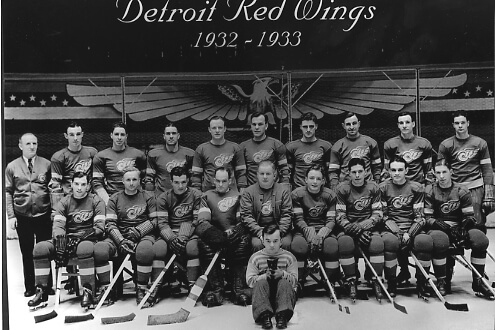
The 1932-33 Red Wings were the first to wear the winged wheel on their sweaters.
The Detroit Red Wings weren’t always known as the Wings. In 1926, the Victoria Cougars of the Western Canadian Hockey League moved nearly en masse from British Columbia to Detroit to form the city’s first National Hockey League team. Club owner Charles Hughes pegged the aggregation the “Detroit Cougars.” This not only helped maintain some continuity between what had been one of pro hockey’s finest teams (Victoria had won the Stanley Cup in 1925) and one of the NHL’s newest, Hughes reasoned that the feline nickname fit in with that of the only other pro sports franchise in town, the baseball Tigers. In fact, the Cougars’ uniforms sported an Olde English D, further borrowing some of the Tigers’ cachet.
The Cougars, unfortunately, were a sad-sack bunch their first few seasons. Before the 1930-31 season, Detroit’s three daily newspapers sought to change the team’s luck by co-sponsoring a contest to find a new nickname. Two thousand entries poured in, with 92 choosing the “Falcons.” (The Wanderers, Trojans, and Magnetos were the other top picks.)
So the Cougars became the Detroit Falcons. New uniforms with gold lettering were designed. This marked the first and only time another color besides the traditional red and white has appeared on the team’s jerseys. All the hoopla over the name change failed to make a difference, however, as the Falcons stunk up the ice in half-filled Olympia Stadium.
By 1932 the Detroit hockey club didn’t have enough money in its coffers to buy its goalie a baseball cap. That year, however, salvation arrived in the form of James “Pops” Norris, a 53-year-old millionaire who made his fortune in the grain business. Norris had tired of operating the Chicago Shamrocks. A former member of the famed amateur Montreal Winged Wheelers in his youth, Norris was anxious to buy an NHL franchise. Norris already owned a big chunk of Chicago Stadium, home of the Blackhawks, and one day he would own the Chicago team itself.
But Norris’s first NHL club was the floundering Detroit franchise, which he purchased in the summer of 1932—along with Olympia Stadium and the Detroit Olympics farm club—for the bargain-basement price of $100,000.
The 1932-33 season was the first in which Detroit players took the ice in their now-iconic blood-red uniforms with the winged wheel crest. Norris, a man who always knew his own mind, didn’t need a newspaper contest to arrive at a new name for his franchise. In a bow to the Montreal Winged Wheelers, he renamed the Falcons the “Red Wings” and borrowed Montreal’s emblem, figuring the emblem fit in perfectly with Detroit’s image as the car capital of the world.
Initially, the Wings’ new red jerseys caused confusion when they visited the Montreal Canadiens, who wore similarly colored game sweaters at home. The league finally solved the problem by ruling that the Red Wings had to wear white pullovers over their sweaters. Eventually, Norris had white jerseys issued for all road games.
Almost from the moment they became Red Wings, Detroit’s hockey team played like men possessed. They had a Cinderella season in 1932-33, climbing from last place to a second-round exit in the playoffs. The following season they won their first divisional crown, and in 1936 and 1937 they won back-to-back Stanley Cups. All in all, not bad for a team that during its first few years couldn’t settle on what to call itself.


